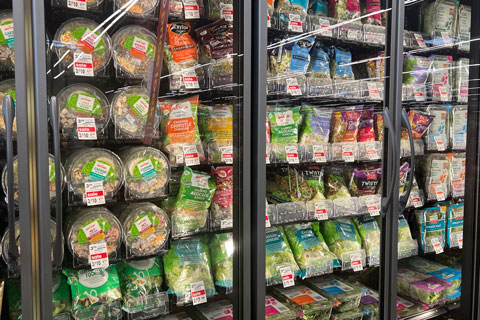5/1/2024
Navigating Salad Kits
Jennifer Polanz

There’s a big jump from growing your own leafy green products, harvesting, packing and shipping them to working with other partners to create a more robust offering. However, the rewards for such a leap could potentially also be big.
How big? The global packaged salad market value clocked in at more than $12 billion last year, with estimated growth of anywhere between 6% and 8% per year for the next 10 years, depending on what market research you look at. Of that, from what I can tell from the research data, North America accounts for nearly 40% of that market.
There are a number of indoor growers already in the space—remember last year’s Global Produce & Floral Show in Anaheim when just about every leafy greens grower introduced a new salad kit option? They were definitely putting the options out there hoping to attract the attention of a supermarket chain or distributor looking for new products to add to their shelves.
But what does it take to make the leap? Turns out, there’s a lot to think about, especially on the food safety side. I tapped two experts to talk about the basics of what growers should know before exploring the realm of salad kits and what resources you can tap into to figure out if it’s the right fit.
Know before you grow
First off, it’s key to understand the regulations regarding food safety and lettuce. I talked to Dr. Jennifer McEntire, the founder of consulting company Food Safety Strategy and prior to that the lead food safety expert at what was then United Fresh Produce Association before it merged with Produce Marketing Association and became the International Fresh Produce Association. We won’t dive into every regulation that impacts salad kits because there are many, but one key thing to note is CEA growers harvesting and packing their own product generally means they’re regulated as a farm under the Produce Safety Rule.
“Once it goes on to be processed, cut and chopped, that’s a different food safety rule. The definition of processing is pretty broad,” Jennifer said, adding the FDA has a rather confusing guidance document about activities that allow you to remain a “farm” and activities that are classified as a processor, which falls under the Preventative Controls For Human Food rules. That means when adding a master pack—or MP of different products that make up a salad kit like croutons, cheese, dressing, etc.—you become a different entity than just a farm.
“Adding an MP is not a farm activity. That moves you to the processing side of things … that categorizes you as a Farm Mixed Type Facility subject to both rules,” she explained. “It’s critically important that CEA growers know if they want to get into the kit business, this does change things from the regulatory perspective.”
 Pictured: Salad kits are becoming an increasingly popular choice at grocery retailers in the U.S.
Pictured: Salad kits are becoming an increasingly popular choice at grocery retailers in the U.S.
To that end, she and my second expert, Dr. Karl Kolb of Ceres University geared toward food safety training, both said it was vital to vet suppliers of the components of the master pack.
“Make a careful and critical examination of your suppliers,” Karl said (he taught the half-day food safety auditing workshop prior to Indoor Ag-Con this year). “Vet them before you need product and as they supply product—vet, vet, vet. And [make sure] each one is GFSI [Global Food Safety Initiative] compliant.
“These good people need to provide consistent supply, consistent quality and consistently good service. You are only as good as your weakest link.”
Jennifer emphasized the liability portion of the regulations, too.
“Even if your direct relationship is with an aggregator who’s putting it all together, you have to have knowledge of who is putting that product together and you have to know their process,” she said. “Your intent doesn’t matter. The way the FDCA [the Federal Food, Drug & Cosmetic Act that gives the FDA authority] is written if you sell food that’s contaminated or receive food that’s contaminated, these are all technically illegal acts. People who are producing food ought to know what they’re getting into. You can’t just blame your supplier if something goes wrong.”
Now, having said that, very seldom does a food safety issue get elevated to a criminal investigation, but it does happen. More often, there’s a recall initiated that can be damaging to a company reputationally and financially. And those recalls fall to the responsibility of the grower who’s putting the kit on the shelves, even if the product causing the recall is in the MP, Jennifer said.
The key components of a kit
The focus on food safety doesn’t stop now. In fact, we’re just getting started. Jennifer talked about the impetus for many recalls, which is improper labeling of the products. In today’s day and age of deadly food allergies, it’s vital to make sure your products are labeled properly at all times. That can get even trickier when working with a company assembling master packs for you.
“We do see recalls because the label says XYZ and the pack that’s in there is the wrong pack,” Jennifer said. “Not only is it the wrong pack, but whatever the pack does contain has an allergen that’s not declared on the label that the consumer might see, so you have to make sure the master pack is the right one.”
That could be why some growers are bringing those suppliers under their umbrella. For example, 80 Acres Farms, an indoor grower based near Cincinnati, Ohio, recently announced they acquired the Mother Raw premium salad dressing business from Reunion Foods Inc., the Toronto-based manufacturer that made their dressings.
Here’s the details from their press release: “Working closely with Mother Raw, we fell in love with their people, their products and their commitment to fresh, healthy ingredients,” 80 Acres Farms co-founder and CEO Mike Zelkind said in the release. “Through vertical integration, the acquisition will streamline operations, expedite innovation and equip us as we grow our national footprint.”
The release continued to say the company is positioned to expand its salad kit product line and develop dressings in-house, and operations will move to one of its Cincinnati-area growing facilities.
That’s one way to ensure the product is being made and labeled properly, but not all growers can do that. Jennifer said it’s key to keep the lines of communication open with the manufacturers of your component products to make sure any changes to the formulations are communicated to update the final packaging.
Third-party audits are especially useful here, and picking suppliers that offer these and continue them regularly provides peace of mind (and a paper trail) for everyone involved. Things to keep in mind with suppliers is their storage and inventory management, and dating for packaging. Lining up the sell-by dates for the leafy greens and the master pack components are important to make sure both are within the same timeframe.
Creating a kit
What else should you consider with a salad kit? Well, there’s packaging for one, which can be a very important component for freshness, quality and durability. If you’re going for a bagged kit versus clamshell, Karl said the right film is important.
“The film may be a single layer or a laminate of several layers of different plastics. The layers can be selectively gas permeable to restrict the amount of oxygen flow into the bag and retain the carbon dioxide,” he explained. “Combined, these films create a MAP, or modified atmosphere packaging where, typically, nitrogen is injected into the bag, or PMAP, a passive modified atmosphere packaging where the packaging and product transpiration will determine the gas mix, to obtain an optimal environment to best maintain shelf life and quality.
“The layers are selected based on the salad mix transpiration and will vary according to variety and sometimes growing location. I don’t know if specific research has been done for indoor ag growing conditions, but this may be an opportunity to look at moving forward.”
Each component added to the mix may change what happens inside, too. “Salad kit items, adding proteins mixing commodities and lastly the amount of moisture remaining in the bag all contribute in some way to the overall quality of the product,” Karl said. “Each one requires a critical analysis to determine their compatibility and focus on the intentions of the marketplace.”
Perhaps the most important point after safety is, does anyone want what you’re selling? That goes for retailers and the end consumer. What are the factors that make your product attractive to the market? The quality and consistency of the product are key here.
“On this note the indoor grower needs to understand their market and build a bag that fits the intended market,” he said. “Consistent supply, consistent quality and consistently good service will propel the indoor grower to the top.
“Think about your supply chain from the market or buyer back through your plant to the manufacturing of the product.”
Yes, manufacturing. That’s because growing your product needs to be as consistent as a manufacturing plant, he added. “Determine over 18 months your demand and then plan to plant and grow what is needed, plus some for crop failure. It will still not be enough.
“Keep it simple to start and don’t believe everything you hear about the next best thing. The major players in the fresh cut industry rely on the tried and true.”
One more key component to entering this market is having back-up plans. When a supplier goes down for any reason, it’s imperative to have someone else you can rely on to continue to produce the finished product. And that all needs to be vetted out in advance, not on the fly.
Who can help
This can all be rather overwhelming to get started and the above is not an exhaustive dive into getting started. But there are good people out there who want these products and their providers to succeed.
So where can you turn to for help? First, your association. The International Fresh Produce Association has helpful resources on everything from best practices for CEA food safety to modified atmosphere packaging and food safety auditing, among other topics. They also have experts on staff who are knowledgeable and can help a grower navigate these waters. The FDA website offers a 16-chapter guidance document for the Preventative Controls for Human Food rules and there’s a whole association dedicated to training people on its requirements at the Food Safety Preventative Controls Alliance.
Jennifer noted it’s also important to work with a food law attorney for a better understanding of the legal aspects surrounding a move into the salad kit market and to talk with regulators about what’s required for compliance. Of course, there are also consultants like her in the industry you can hire, as well.
“It’s achievable; I don’t want them to be dissuaded from a good market opportunity, but they have to go in with eyes wide open understanding what needs to be done and how to do it,” she added.
Karl had similar sentiments. “Indoor growing presents challenges that the traditional farmer has overcome and prospered,” he said. “We will overcome our challenges, too. As indoor growing is space age, so is bagging produce and the next best thing.”
For More Information
You can find more resources at these websites:
■ International Fresh Produce Association: freshproduce.com
■ FDA: fda.gov/regulatory-information
■ Food Safety Preventative Controls Alliance: fspca.net
■ Ceres University: ceres.university
■ Food Safety Strategy LLC: foodsafetystrategy.com